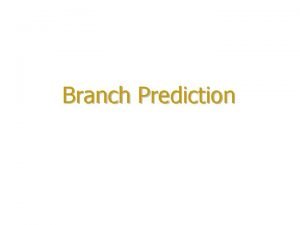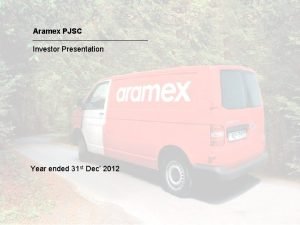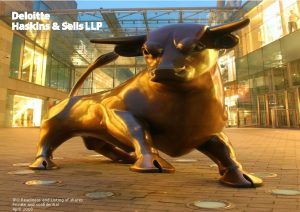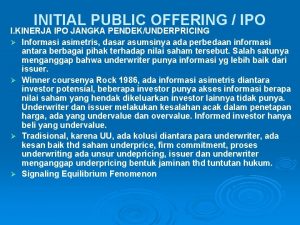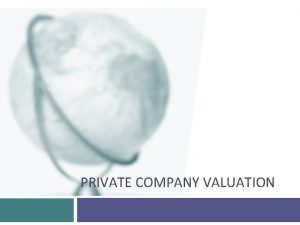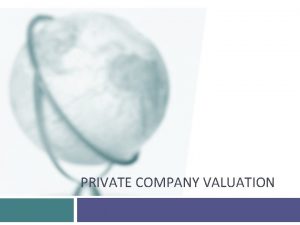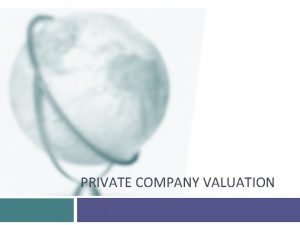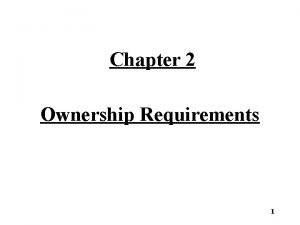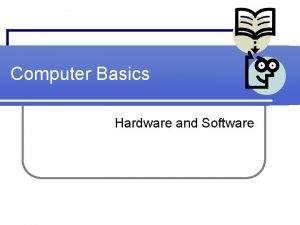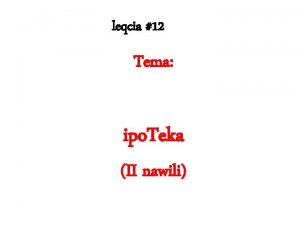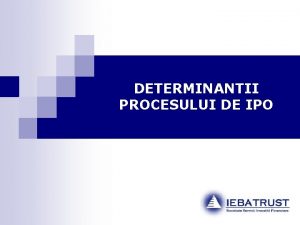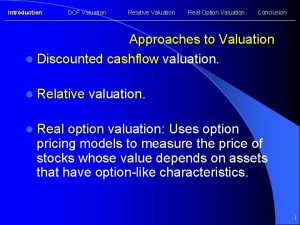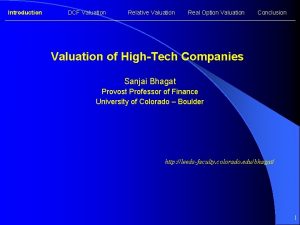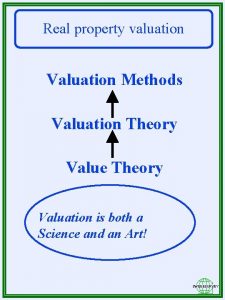Ownership Structure and IPO Valuation Yeh YinHua and

















- Slides: 17

Ownership Structure and IPO Valuation Yeh Yin-Hua and Pei-Gi Shu Fu-Jen Catholic University

Introduction n How does the ownership structure of an IPO firm affect the price settings and the initial returns? l Managerial monitoring consideration l Brennan and Franks (1997) : the reduced monitoring hypothesis excess demand for issued shares through underpricing to reduce the likelihood of being monitored by institutional shareholders l Smart and Zutter (2003) find that with voting control secured in the first place, dual-class IPOs experienced less underpricing than single-class IPOs. 2

Introduction l Other than monitoring considerations, the controlling shareholder’s wealth effect is implied in the ownership structure, which in turns affects the IPO price setting. l IPO price setting monitoring consideration diverse -ownership economies l In ownership-concentrated economies, the controlling shareholders’ voting rights are well-entrenched before IPOs. l The wealth effect ownership-concentrated economies 3

Introduction l The ownership structure manifests the controlling shareholders’ motives and stakes in the negotiations and provides convincing signals to the underwriter and outside investors. l Firm’s IPO is a continuously negotiating process: controlling shareholders of issuing firms, associated underwriters, and outside investors the IPO price multiples and initial returns. 4

IPOs Controlling Shareholder Price Multiple Underwriters Initial Return Investors 5

Introduction n The interest-alignment hypothesis (La Porta et al. , 2002; Claessens et al. , 2002) l Controlling shareholder: High cash flow rights high offering price l Underwriters: accept high offering price l In addition, the C. S. with high cash flow rights does not need to have a low offering price to reduce outside monitoring. n Hypothesis 1: The comparable price multiples of IPO firms are positively correlated with the C. S. cash flow rights. 6

The Negative expropriation hypothesis n n The C. S. having voting rights far exceeding their cashflow rights, the underwriters on behalf of outside investors worry about the possibility of wealth exploitation by the C. S. and are reluctant to spare a higher offer price. n Since these C. S. only have to bear a small portion of underpricing costs, they would not be as insistent as when they have high cash-flow rights. Hypothesis 3: The comparable price multiples of IPO firms are negatively correlated with the divergence between the C. S. degree of cash flow rights and voting rights. 7

Introduction n The initial return l The initial returns are further intervened by outside investors. l A positive relation between cash-flow rights and initial returns and a negative relation between a deviating voting-cash structure and initial returns l Outside investors are inaccessible to the information which might blur the predicted relations 8

Data and Methodology n Our sample consists of 218 Taiwanese IPO firms in 1992 -2001 sampling period. n Corporate governance l l l Ownership: voting rights, cash flow rights, deviation Second largest shareholder Board composition: the proportion the directors and supervisors represented by the controlling shareholder 9

Variables n IPO price multiple l l n We value IPOs using price multiples, such as offering price-to-book, price-to-sales, and price-to-EBITDA 3 yeas average prior to IPO. These price multiples deflated by the multiples of matching firm. Initial return l the initial return of an IPO as the difference between the price on the first day that is not closed at the limit and the offer price divided by the offer price. 10

Year Cash flow P/B IPO rights P/B matching P/B DM P/S DM P/EBITDA DM 3. 271 1. 937 1. 730 1. 355 TSMC 1994 54. 52 6. 338 UMC 11

Basic Statistics Mean S. D. Q 1 Media n Q 3 Voting Rights (%) 38. 481 21. 831 22. 179 36. 070 54. 001 Cash Flow Rights (%) 31. 395 20. 475 15. 935 27. 910 43. 338 Voting Rights – Cash Flow Rights (%) 7. 085 10. 354 0. 000 2. 320 11. 030 Cash Flow Rights/Voting Rights (%) 81. 390 23. 153 64. 803 93. 374 100. 00 Dummy (Second Largest Shareholder) 0. 468 0. 500 0. 000 1. 000 Dummy (Pyramidal) 0. 312 0. 464 0. 000 1. 000 Dummy (Cross Shareholding) 0. 133 0. 340 0. 000 Proportion of Directorates and Supervisors (%) 39. 445 20. 253 25. 000 37. 500 50. 000 Variable Panel A: Ownership Structure Panel B: Price Multiples of IPOs (deflated by the Multiples of Matching Sample) 3 -year averaged (Price/Book Value per share) Prior to IPO 1. 166 0. 816 0. 678 0. 984 1. 394 3 -year averaged (Price/Sales per share) Prior to IPO 1. 204 2. 941 0. 338 0. 589 1. 133 3 -year averaged (Price/EBITDA per share) Prior to IPO 1. 006 1. 894 0. 416 0. 648 0. 957 Initial Returns (%) 29. 024 33. 753 4. 051 18. 533 48. 669 Adjusted Initial Returns (%) 28. 967 33. 612 5. 072 18. 996 46. 729 Panel C: Initial Returns 12

Regression of Price-to-Book Multiple on Corporate Governance Dependent Variable: IPO Price-to-Book Multiple deflated by Matching Sample Independent Variable Intercept Cash flow Rights -0. 440 (-0. 583) -0. 265 (-0. 353) -1. 120 (-1. 336) -0. 244 (-0. 322) -0. 307 (-0. 410) 0. 009 (1. 985)** -0. 012 (-1. 372) Voting Rights – Cash Flow Rights -0. 023 (-2. 024)** 0. 009 (2. 324)** Cash Flow Rights / Voting Rights Proportion of Directorates and Supervisors 0. 001 (0. 289) Dummy (Cash Flow Rights) * (Voting Rights – Cash Flow Rights) -0. 011 (-1. 688)* 0. 022 (1. 701)* Dummy (Cash Flow Rights) * Proportion of Directorates and Supervisors R 2 (%) -0. 298 (-0. 399) 0. 013 (2. 631)*** 16. 69 15. 95 17. 40 15. 19 16. 90 18. 07 13

Regression of Price-to-Sales Multiple on Corporate Governance Dependent Variable: IPO Price-to-Sale Multiple deflated by Matching Sample Independent Variable Intercept 1. 398 (1. 343) Cash flow Rights 0. 008 (1. 837)* 1. 410 (1. 378) 0. 445 (0. 386) 1. 586 (1. 523) -0. 027 (-2. 336)** Voting Rights – Cash Flow Rights 1. 367 (1. 346) -0. 037 (-2. 544)** 0. 011 (2. 138)** Cash Flow Rights / Voting Rights Proportion of Directorates and Supervisors -0. 0004 (-0. 064) Dummy (Cash Flow Rights) * (Voting Rights – Cash Flow Rights) 0. 010 (-1. 072) 0. 022 (1. 138) Dummy (Cash Flow Rights) * Proportion of Directorates and Supervisors R 2 (%) 1. 513 (1. 456) 0. 010 (1. 516) 29. 00 30. 40 30. 09 28. 44 30. 87 29. 28 14

Regression of the Initial Return of IPO on Corporate Governance Dependent Variable: Initial Return of IPO Independent Variable Intercept 19. 740 (1. 015) Cash flow Rights -0. 016 (-0. 136) 17. 551 (0. 922) 1. 135 (0. 053) 18. 950 (0. 982) -0. 422 (-1. 947)* Voting Rights – Cash Flow Rights 16. 726 (0. 875) -0. 520 (-1. 886)* 0. 179 (1. 849)* Cash Flow Rights / Voting Rights Proportion of Directorates and Supervisors 0. 023 (0. 185) Dummy (Cash Flow Rights) * (Voting Rights – Cash Flow Rights) -0. 125 (-0. 736) 0. 204 (0. 575) Dummy (Cash Flow Rights) * Proportion of Directorates and Supervisors R 2 (%) 17. 742 (0. 920) 0. 154 (1. 292) 11. 08 12. 78 12. 62 11. 09 12. 93 11. 85 15

Conclusion n Ownership structure variables have stronger explanatory power upon the comparable price multiples than upon initial returns of IPO firms. n With high cash flow investment in the issuing firms, the C. S. have a strong motive to ask high comparable price multiples. 16

Conclusion n However, a deviating ownership structure that the C. S. levers control through cross shareholding or pyramidal structure is negative correlated to comparable price multiples. n The negotiation of the offering price is strictly dictated by the controlling shareholder’s wealth effect is implied in the ownership structure of the IPO firm. 17
 Jetblue airways ipo valuation
Jetblue airways ipo valuation Fixed income valuation methods
Fixed income valuation methods Ntu fcfs form
Ntu fcfs form Jason yeh md
Jason yeh md Peter yeh md
Peter yeh md Dr alex yeh
Dr alex yeh Bibi zehra ye dua hai lyrics in urdu written
Bibi zehra ye dua hai lyrics in urdu written Beauty poem explanation
Beauty poem explanation Fina3210
Fina3210 Tse yu yeh
Tse yu yeh Forrest voight
Forrest voight Albert yeh
Albert yeh Aramex ownership structure
Aramex ownership structure Ipo programming
Ipo programming Deloitte ipo roadmap
Deloitte ipo roadmap Input process output paradigm
Input process output paradigm Ipo winr ditunda
Ipo winr ditunda Ipo chart in problem solving
Ipo chart in problem solving









